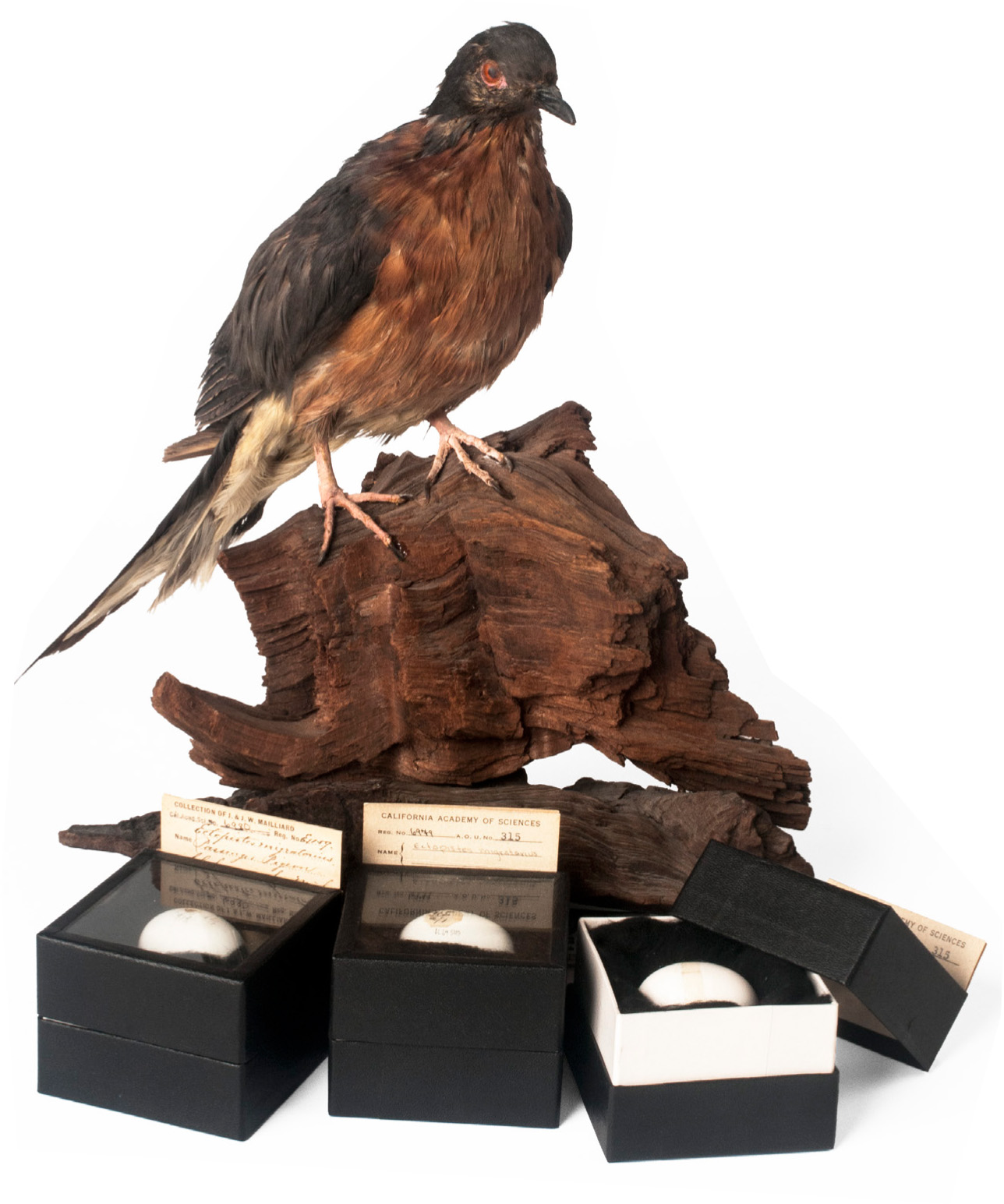Please note: Osher Rainforest will be closed for maintenance Jan. 14–16.
Science News
Undoing Extinction
September 25, 2013
by Andrew Ng
0

Can scientists pull off a real-life version of Jurassic Park? This intriguing question received a lot of attention earlier this year, when Revive & Restore (a project of the San Francisco-based Long Now Foundation) announced their goal of reviving extinct species using cutting-edge DNA technology. Dinosaurs have been gone too long for DNA to still be intact, but animals that went extinct during human history could potentially make a comeback. One of the first candidates for “de-extinction”—the iconic passenger pigeon (Ectopistes migratorius).
In the early 1800s, the passenger pigeon was the world’s most abundant bird species, even though its range was limited to eastern and central North America. Flocks of passenger pigeons—which sometimes included millions of birds—were so vast, they darkened swaths of sky up to a mile wide. But intensive hunting and habitat destruction by humans drove this species to extinction in a shockingly short span of time. The last passenger pigeon, “Martha,” died in 1914 at the Cincinnati Zoo. Her body remains at the Smithsonian’s National Museum of Natural History.
The Academy’s research collection houses nine specimens and three eggs of this species, dating to the late 1800s. Century-old specimens like these can still provide valuable information for modern-day studies. For example, Academy curator Jack Dumbacher and his colleagues published a paper in 2010 revealing that the closest living relative of the passenger pigeon is not the mourning dove, as many had suspected, but the band-tailed pigeon (Patagioenas fasciata), which is found along the Pacific coast and in the southwestern U.S., and can be seen in oak forests in the Bay Area. DNA sampling from museum specimens provided crucial data for this study. And the study’s conclusion provides critical information about which living relative could serve as a surrogate parent for the passenger pigeon, as scientists move forward with trying to revive this lost species.
Science Today sat down with Jack Dumbacher, who is also a scientific advisor to the Long Now Foundation, for his insights into de-extinction.
Where does the process currently stand?
JD: The Long Now Foundation has assembled a team of scientists to tackle different aspects of this project. Graduate student Ben Novak, working in Beth Shapiro’s lab at UC Santa Cruz, is refining the sequencing of the passenger pigeon genome from museum specimens. The genome of the band-tailed pigeon (the closest living relative) is also being sequenced.
Once the genomes are assembled, what happens next?
JD: You have to compare the genomes to determine which stretches of DNA make a passenger pigeon a passenger pigeon. Then you take the genome of a band-tailed pigeon and convert those important stretches of DNA into passenger pigeon DNA. George Church’s lab at Harvard is working on ways to do this using “CRISPR” technology—using bacterial proteins to genetically engineer specific DNA sequences and direct mutations to occur in a predictable way.
Let’s say scientists successfully get this DNA into an embryo, and the embryo becomes a chick. Is it a true passenger pigeon?
JD: That’s the big challenge. It may still have some band-tailed pigeon DNA. And you have to think about its behavior. How will it learn to be a passenger pigeon, find food, and avoid predators? Teams of researchers are tackling these numerous considerations and challenges.
Some might say that extinct animals went extinct for a reason, and bringing them back is not a good idea. How would you respond
JD: Animals like the passenger pigeon and moa went extinct due to human activity. So going extinct “for a reason” was humans to begin with. Also, developing the technology to successfully de-extinct an animal would itself be an intellectual coup, one that might have unforeseen benefits. The technology could be useful in other aspects of life, like agriculture, animal husbandry, conservation of endangered species, and, potentially, even human health. Think of the Space Race and all the accompanying benefits to society that resulted from that fundamental scientific research and development.
What other ethical concerns have come up?
JD: The ideal goal is to release de-extincted passenger pigeons back into their native habitat. But you have to be careful not to harm any other species whose survival may be on the brink. Their original ecosystem (the forests of the eastern and central U.S.) has changed. You don’t want to upset the balance in a way that threatens additional species. But the idea of restoring a habitat with native species is not a new one. Biologists restore habitats all the time. Had the pigeon survived only in captivity, we would be excited to be able to re-release it. Having survived only in our freezers or museum drawers, is that so different?
How many years away are we from seeing a real, live passenger pigeon?
JD: Optimistically, I would be very excited if this could happen in the next five to ten years. If not, I am confident that some day, we will have the technology to do this. Now is a good time to start thinking critically about what such a technology and ability would mean.
Andrew Ng is Communications Manager at the California Academy of Sciences.
0